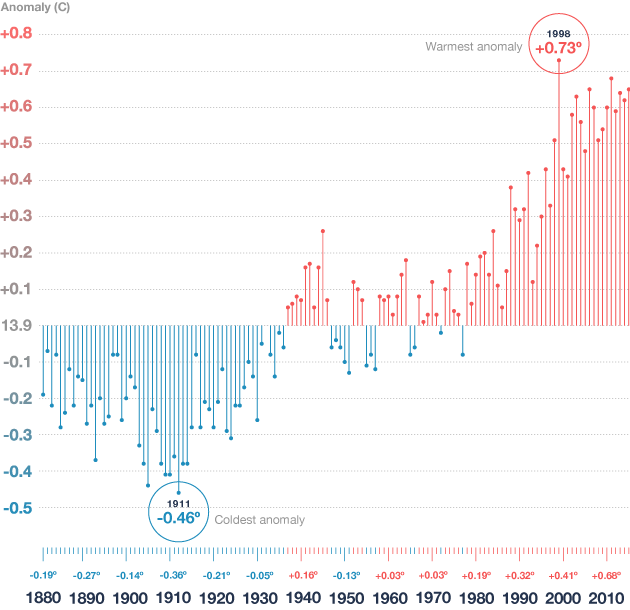Climate Change
Featured Online Programs
Rising Temperature
In recent years, scientists have noted a rapid increase in average temperatures throughout the country. According to a report from the National Resources Defense Council (NRDC) titled ‘Killer Summer Heat,’ the average temperature of the United States could rise by as many as 11 degrees Fahrenheit by the end of the 21st century. “The risks to public health are greatest when high temperatures mix with other weather conditions to cause what’s known as an ‘Excessive Heat Event,’ or EHE,” the report states. EHE days occur when the temperature, dew point temperature, cloud cover, wind speed and surface atmospheric pressure create conditions dangerous enough to cause heat-related deaths.

Data via NCDC. According to four major global meteorological and atmospheric monitoring agencies, temperatures have gradually risen for the past 30 years; the 2000s have officially been declared the warmest decade in recorded history.
Most climate change experts agree that greenhouse gases ― which trap heat and prevent it from leaving the Earth’s atmosphere ― are mostly responsible for the temperature spike. Even with a worldwide emphasis on reduced greenhouse emissions, temperatures continue to climb. An article in Science Daily recently noted that in March 2012 alone, more than 15,000 single-day warm temperature records were broken throughout the United States.
Previous EHEs (such as the massive heat wave that struck Southern California in 2006) have each been responsible for thousands of deaths and injuries; now, the NRDC projects that as many as 150,000 Americans will die due to climate change by the year 2100. The Centers for Disease Control (CDC) notes that elderly individuals, infants and chronically ill people are considered the most vulnerable for heat-related deaths. The most common causes of death related to rising temperatures include the following conditions:
- Heat exhaustion:According to The Mayo Clinic, heat exhaustion is characterized by profuse sweating and a rapid pulse/heartbeat; these two symptoms essentially indicate the body is overheating. Other signs of heat exhaustion include dizziness, low blood pressure and muscle cramps. Individuals who suspect they have heat exhaustion should immediately stop whatever they are doing, retreat to a relatively cool location, and consume cool water or electrolyte-filled sports drinks.
- Heat stroke: Heat stroke could be characterized as ‘advanced heat exhaustion’; the Mayo Clinic notes that individuals diagnosed with heat stroke usually have a temperature in excess of 104 degrees Fahrenheit. In addition to the outside temperature, the symptoms of heat stroke may be exacerbated by prescription medication, preexisting medical conditions, high humidity and even consuming alcohol on a hot day. Unlike heat exhaustion, heat stroke demands medical attention; untreated heat stroke can negatively affect the brain, heart, kidneys and muscles.
- Cardiovascular disease:According to the National Institute of Environmental Health Science, extreme heat (as well as extreme cold) has been linked to a higher incidence rate of cardiovascular diseases and conditions, such as strokes and dysrhythmia. Cardiovascular disease is already the deadliest medical condition in the United States, and strokes are listed as the country’s third leading cause of death.
- Kidney disease: Prolonged exposure to excessively hot temperatures can lead to major kidney problems, notes American Family Physician contributor James L. Glazer, M.D. Rhabdomyolysis, a condition caused by damaged tissue, often results from heat stroke and has been linked to long-term renal disease. The body’s ability to regulate water intake may also be affected, which can lead to kidney and/or bladder infections.
- Aggravated allergies: Since two major allergens ― pollen and ragweed ― spread during relatively warm months; the EPA notes that spring allergy seasons are occurring earlier each year as a result of increasing temperatures.
In addition to the human toll, there is a significant financial impact to consider. ‘Killer Summer Heat’ discusses a heat wave that struck California in Summer 2006. Over the two-week period of extreme heat, 655 people lost their lives and more than 16,000 individuals made trips to the emergency room; the heatwave ultimately resulted in costs nearing $5.3 billion. The report notes that as many as 150,000 men, women and children could potentially die of heat-related causes by the year 2100.
